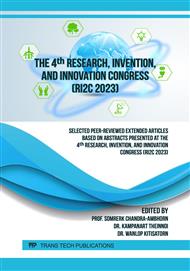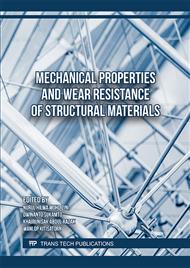[1]
S.C. Singhal, Solid oxide fuel cells for stationary, mobile, and military applications, Solid State Ionics, 152 (2002) 405-410.
DOI: 10.1016/s0167-2738(02)00349-1
Google Scholar
[2]
J. Larminie, A. Dicks, M.S. McDonald, Fuel cell systems explained, J. Wiley Chichester, UK, 2003.
Google Scholar
[3]
K. Huang, J.B. Goodenough, Solid Oxide Fuel Cell Technology: Principles, performance and operations, Woodhead Publishing Limited, Cambridge, UK, 2009.
Google Scholar
[4]
Z.G. Yang, J.W. Stevenson, P. Singh, Solid oxide fuel cells, Pacific Northwest National Laboratory (PNNL), Richland, WA (US), 2003.
DOI: 10.2172/965697
Google Scholar
[5]
Solid Oxide Fuel Cells: Materials Properties and Performance
Google Scholar
[6]
S. Chandra-ambhorn, T. Thublaor, P. Wiman, High temperature oxidation of AISI 430 stainless steel in Ar-H2O at 800 ºC, Corrosion Science, (2020) 108489.
DOI: 10.1016/j.corsci.2020.108489
Google Scholar
[7]
P. Promdirek, G. Lothongkhum, S. Chandra‐ambhorn, Y. Wouters, A. Galerie, Behaviour of ferritic stainless steels subjected to dry biogas atmospheres at high temperatures, Materials and Corrosion, 62 (2011) 616-622.
DOI: 10.1002/maco.201005878
Google Scholar
[8]
K. Chouhan, S. Sinha, S. Kumar, S. Kumar, Simulation of steam reforming of biogas in an industrial reformer for hydrogen production, International Journal of Hydrogen Energy, 46 (2021) 26809-26824.
DOI: 10.1016/j.ijhydene.2021.05.152
Google Scholar
[9]
Y. Unpaprom, T. Pimpimol, K. Whangchai, R. Ramaraj, Sustainability assessment of water hyacinth with swine dung for biogas production, methane enhancement, and biofertilizer, Biomass Conversion and Biorefinery, 11 (2021) 849-860.
DOI: 10.1007/s13399-020-00850-7
Google Scholar
[10]
X. Chen, P.Y. Hou, C.P. Jacobson, S.J. Visco, L.C. De Jonghe, Protective coating on stainless steel interconnect for SOFCs: oxidation kinetics and electrical properties, Solid State Ionics, 176 (2005) 425-433.
DOI: 10.1016/j.ssi.2004.10.004
Google Scholar
[11]
H. Kurokawa, K. Kawamura, T. Maruyama, Oxidation behavior of Fe–16Cr alloy interconnect for SOFC under hydrogen potential gradient, Solid State Ionics, 168 (2004) 13-21.
DOI: 10.1016/j.ssi.2004.02.008
Google Scholar
[12]
T. Brylewski, M. Nanko, T. Maruyama, K. Przybylski, Application of Fe–16Cr ferritic alloy to interconnector for a solid oxide fuel cell, Solid State Ionics, 143 (2001) 131-150.
DOI: 10.1016/s0167-2738(01)00863-3
Google Scholar
[13]
T. Thublaor, S. Chandra-ambhorn, High temperature oxidation and chromium volatilisation of AISI 430 stainless steel coated by Mn-Co and Mn-Co-Cu oxides for SOFC interconnect application, Corrosion Science, 174 (2020) 108802.
DOI: 10.1016/j.corsci.2020.108802
Google Scholar
[14]
T. Thublaor, P. Wiman, T. Siripongsakul, S. Chandra-ambhorn, Development of annealed Mn–Co and Mn–Co–Cu coated AISI 430 stainless steels for SOFC interconnect application, Oxidation of Metals, 96 (2021) 93-103.
DOI: 10.1007/s11085-021-10052-9
Google Scholar
[15]
J. Wu, X. Liu, Recent development of SOFC metallic interconnect, Journal of Materials Science and Technology, 26 (2010) 293-305.
DOI: 10.1016/s1005-0302(10)60049-7
Google Scholar
[16]
I. Barin, Thermochemical Data of Pure Substances, VCH, Germany, 1995.
Google Scholar
[17]
M.J. Monteiro, S.R.J. Saunders, F.C. Rizzo, The Effect of Water Vapour on the Oxidation of High Speed Steel, Kinetics and Scale Adhesion, Oxidation of Metals, 75 (2011) 57-76.
DOI: 10.1007/s11085-010-9220-8
Google Scholar
[18]
S. Chandra-ambhorn, P. Saranyachot, T. Thublaor, High temperature oxidation behaviour of Fe–15.7 wt.% Cr–8.5 wt.% Mn in oxygen without and with water vapour at 700 ºC, Corrosion Science, 148 (2019) 39-47.
DOI: 10.1016/j.corsci.2018.11.023
Google Scholar
[19]
P. Wiman, A. Muengjai, P. Srihathai, T. Thublaor, T. Siripongsakul, W. Chandra-ambhorn, S. Chandra-ambhorn, Oxidation and scale adhesion of a type 430 stainless steel in Ar–CO2 gas mixtures at 800 °C, High Temperature Corrosion of Materials, (2023)
DOI: 10.1007/s11085-023-10155-5
Google Scholar
[20]
E.J. Opila, D.L. Myers, N.S. Jacobson, I.M. Nielsen, D.F. Johnson, J.K. Olminsky, M.D. Allendorf, Theoretical and experimental investigation of the thermochemistry of CrO2(OH)2(g), The Journal of Physical Chemistry A, 111 (2007) 1971-1980.
DOI: 10.1021/jp0647380
Google Scholar
[21]
G.R. Holcomb, Calculation of reactive-evaporation rates of chromia, Oxidation of Metals, 69 (2008) 163-180.
DOI: 10.1007/s11085-008-9091-4
Google Scholar
[22]
W. Wongpromrat, H. Thaikan, W. Chandra-ambhorn, S. Chandra-ambhorn, Chromium vaporisation from AISI 441 stainless steel oxidised in humidified oxygen, Oxidation of Metals, 79 (2013) 529-540.
DOI: 10.1007/s11085-013-9379-x
Google Scholar



